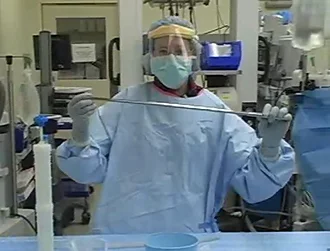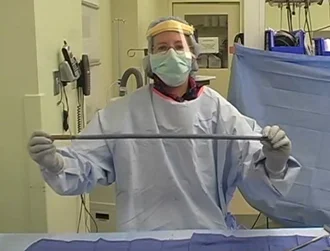Antibiotic Cement-Coated Rods or Nails
As a patient, being told there is infection present in your bone can be devastating. At the International Center for Limb Lengthening, your surgeon may have told you that you would benefit from an antibiotic cement-coated rod or nail.
What is an antibiotic cement-coated nail or rod, and how does it work?
An antibiotic cement-coated nail or rod is a piece of hardware that is used for internal fixation or repair of broken or infected bone, also called osteomyelitis. The rod itself is a thin cylindrical device made of metal that is used to stabilize broken bone. We take orthopedic cement, technically called polymethyl methacrylate, (similar to what is used to hold a knee replacement in place), and put powdered antibiotic into the mixture. This creates a viscous, play-dough like substance that can be placed onto the rod, to treat infection internally. Prior to the cement hardening, it is molded on to the surface of the rod or nail, and allowed to cure. Once hard, this rod may then be inserted in the same way non coated rod is placed, with the added benefit of local antibiotic to treat infection.
 Dr. Janet Conway holding up a simple (uncoated) intramedullary nail
Dr. Janet Conway holding up a simple (uncoated) intramedullary nail Dr. Janet Conway holding up an antibiotic cement-coated nail
Dr. Janet Conway holding up an antibiotic cement-coated nail
The antibiotics that are in the cement leach out slowly over a period of 4-6 weeks, giving extremely high concentrations of antibiotics only in the bone where they are needed most. As most of the antibiotics stay in the bone, there is less risk of toxicity to organs (e.g., liver, kidney).
Click here to watch a video of Dr. Conway creating an antibiotic cement-coated intramedullary nail.
When is using antibiotic cement-coated rods or nails a good option?
You may benefit from this if you have had history of infection with prior surgery, have had an open fracture (where bone is exposed to the outside world), or have complex medical problems that place you in a high-risk situation for infection such as diabetes, poor blood flow, active infection, previous orthopedic surgery or previous infection in the affected bone.
What happens during surgery?
During the surgery, you will be placed under anesthesia, and surgery will proceed much the same way as having a simple (uncoated) rod placed, with the only exception being placement of the cement on the rod prior to insertion. Prior to inserting the rod, the central marrow canal of the bone is reamed with special drills to remove dead or infected bone. After a thorough washing of the bone, the rod is put in. Coating the rod with cement takes under five minutes, and it hardens in around 10 minutes. You would not notice a difference compared with the non-coated rod, as the rod is placed into the canal in the center of the bone. Once the rod is in place, screws are placed at the top and bottom of the rod to hold it in place inside the bone. Your incisions are closed with sutures or staples, and you are taken to the recovery room.
What happens after surgery?
The antibiotic in the cement will continue to elude into the bone/tissues at the site of infection for 4-6 weeks. After surgery, you will likely need intravenous (IV) antibiotics for several weeks to adequately treat the infection in the bone, as this is the standard of care for bone infection. A PICC line, (a thin, soft, long catheter or tube), may be placed in one of your arm veins for long-term IV administration.
After surgery, the surgical team generally waits 2-3 days for cultures to return so that you may be placed on the correct IV antibiotic targeted at the specific bacteria that caused the infection. Once you are on the right antibiotics, you can be discharged from the hospital. A social worker will work with the team to check with medical insurance on antibiotic coverage at home. In some cases, patients are required to be placed in a skilled nursing facility for duration of the antibiotic treatment through the PICC line. At the end of treatment, the PICC line is removed. Eventually, once the infection has been vanquished, the antibiotic cement-coated rod may be removed. This is typically done on an outpatient visit.
What are the risks of this type of surgery?
The risks for this surgery are much the same as any other major orthopedic surgery. There is a very small risk of having higher levels of antibiotic in the blood as well, due to the local administration of antibiotic from the cement, and so blood work is taken periodically to monitor kidney and liver function.
